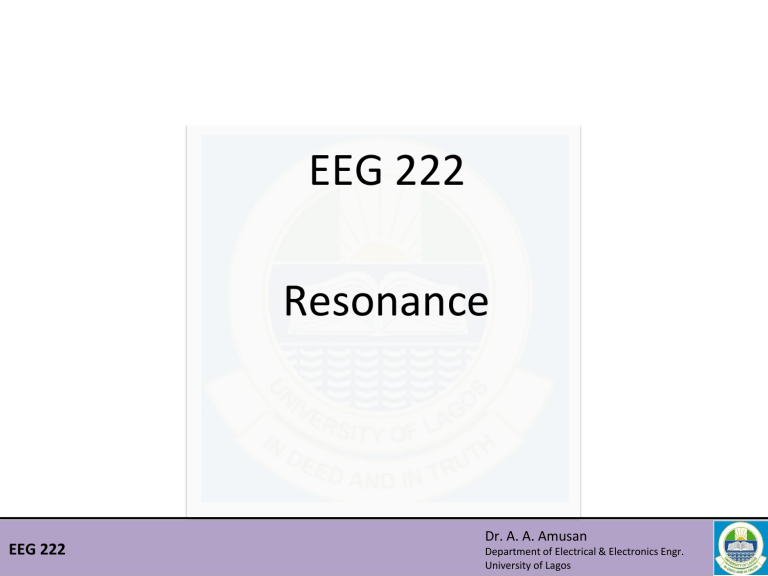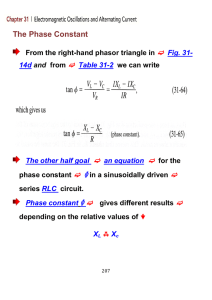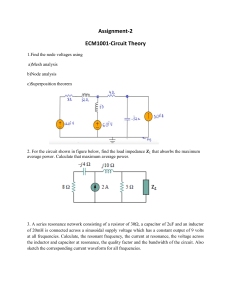
EEG 222 Resonance EEG 222 Dr. A. A. Amusan Department of Electrical & Electronics Engr. University of Lagos Learning Outcome 1. Understand the following concepts: Frequency response Resonance 2. Analyse a parallel RLC resonant circuit with respect to resonance frequency, impedance, output voltage/ current, power, bandwidth and Q-factor. 2. Analyse a series RLC resonant circuit with respect to resonance frequency, frequency, impedance, output voltage/ current, power, bandwidth and Q-factor. 4. Design filters based on RLC resonant circuits EEG 222 Frequency response • Behavior of our circuit can change dramatically depending on the frequency (or frequencies) of operation • Frequency response is the quantitative measure of the output spectrum of a system or device in response to a stimulus, and is used to characterize the dynamics of the system. It is a measure of magnitude and phase of the output as a function of frequency, in comparison to the input. EEG 222 Loudspeakers frequency response and frequency response digitally fixed. Source wikipedia Resonance • A notable feature of the frequency response of a circuit is the sharp resonant peak (or dip) exhibited on the amplitude (magnitude ) characteristics. • Resonance occurs in any circuit with complex conjugate pair of poles i.e any circuit with at least one inductor and capacitor. • In a two-terminal electrical network containing at least one inductor and one capacitor, we define resonance as the condition which exists when the input impedance of the network is purely resistive. • In an electrical circuit, resonance condition exists when the inductive reactance and the capacitive reactance are of equal magnitude, causing electrical energy to oscillate between the magnetic field of the inductor and the electric field of the capacitor. • Resonance is used for tuning and filtering, because resonance occurs at a particular frequency for given values of inductance and capacitance. Resonance can be detrimental to the operation of communications circuits by causing unwanted sustained and transient oscillations that may cause noise, signal distortion, and damage to circuit elements. EEG 222 Analysis of series R-L-C resonant circuit 𝑍𝑐 = 1 𝑠𝐶 𝑍𝐿 = 𝑠𝐿 Z=𝐻 𝑠 = Z=𝐻 𝑠 = 𝑉 𝐼 𝑉 𝐼 = 𝑅 + 𝑍𝐿 + 𝑍𝑐 1 = 𝑅 + 𝑠𝐿 + 𝑠𝐶 Let s = 𝑗𝛚 Z = 𝐻 𝑗𝛚 = 𝑉 𝐼 1 = 𝑅 + 𝑗𝛚𝐿 + 𝑗𝛚𝐶 1 𝐻 𝑗𝛚 = 𝑅 + 𝑗𝛚𝐿 + 𝑗𝛚𝐶 EEG 222 Analysis of series R-L-C resonant circuit Recall, resonance condition is when the inductive reactance and the capacitive reactance are of equal magnitude. This implies that the imaginary part of the frequency response is zero at resonance. 𝐼𝑚 𝐻 𝑗𝛚 = 0 1 𝑗𝛚𝐿 + =0 𝑗𝛚𝐶 𝑗 𝑗𝛚𝐿 − =0 𝛚𝐶 1 𝛚𝐶 = 𝛚𝐿 1 𝛚0 = 𝐿𝐶 1 f0 = 2π 𝐿𝐶 𝛚 0 is the resonance angular frequency in (rad / seconds) f0 is the resonance frequency in Hertz EEG 222 Important points in series R-L-C resonant circuit At resonance for series rlc the series LC circuit acts like a short circuit, hence all the circuit current flows through the resistor, R only. Total impedance (H(jw)) of a series resonance circuit at resonance is R, which is the minimum circuit impedance. At resonance, Z = 𝐻 𝑗𝛚 = 𝑅 is minimum for series resonance. Circuit current and voltage is in phase at resonance, hence power factor is unity Circuit current is maximum at resonance, while the circuit voltage is minimum EEG 222 Impedance of series R-L-C resonant circuit 𝑍 = 𝑅 + 𝑗𝛚𝐿 − 𝑍 = EEG 222 𝐽 𝛚𝐶 1 𝑅2 + 𝛚𝐿 − 𝛚𝐶 2 Current in series R-L-C resonant circuit 𝐼= 𝑉 𝑉 = 𝑍 𝑅 + 𝑗𝛚𝐿 − 𝐽 𝛚𝐶 𝐼 = 𝑉 1 𝑅 2 + 𝛚𝐿 − 𝛚𝐶 2 Note: Circuit current is maximum at resonance Circuit voltage behaves like impedance, which is minimum at resonance EEG 222 Power: series R-L-C circuit Power is dissipated in the resistor 2 𝑉 𝑟𝑚𝑠 2 𝑃𝑎𝑣𝑔 = 𝐼𝑟𝑚𝑠 𝑅= 𝑅 𝑍 𝑉 Highest power is dissipated at resonance frequency where 𝐼 𝛚0 = 𝑚 𝑃𝑚𝑎𝑥 = 𝑃 𝛚0 = 𝑉𝑟𝑚𝑠 2 𝑍 𝑅 𝑉𝑚 2 ×𝑅 = 2 𝑅 ×𝑅 = 2 1 𝑉𝑚 2 𝑅 We define 𝛚1 and 𝛚2 as the half power frequencies. This is the frequencies at which the power dissipated becomes half the maximum value. 𝑃(𝛚0 ) 1 𝑉𝑚2 𝑃 𝛚1 = 𝑃 𝛚2 = = 2 4 𝑅 Half power current value 𝐼 𝛚1 = 𝐼 𝛚2 = EEG 222 𝐼 𝛚0 2 = 𝑉𝑚 𝑅 2 Half power frequencies – series RLC cct 𝑉𝑚 𝐼 = 𝑅2 1 + 𝛚𝐿 − 𝛚𝐶 1 1 + 𝛚𝐿 − 𝛚𝐶 1 2 𝑅 + 𝛚𝐿 − 𝛚𝐶 𝑅2 2 2 = = 𝑉𝑚 𝑅 2 1 𝑅 2 2 = 2𝑅2 2 𝛚2 𝐿𝐶 − 𝛚𝑅𝐶 − 1 = 0 𝛚= 𝑅𝐶± 𝑅2 𝐶 2 +4𝐿𝐶 2𝐿𝐶 𝑅 𝑅 2 𝛚2 = 2𝐿 + EEG 222 2𝐿 1 𝛚𝐿 − = 𝑅2 𝛚𝐶 1 𝛚𝐿 − = ±𝑅 𝛚𝐶 𝛚2 𝐿𝐶 − 1 = ±𝛚𝑅𝐶 or 𝛚2 𝐿𝐶 + 𝛚𝑅𝐶 − 1 = 0 or + 1 𝐿𝐶 𝛚= and −𝑅𝐶± 𝑅2 𝐶 2 +4𝐿𝐶 2𝐿𝐶 𝛚1 = −𝑅 2𝐿 + 𝑅 2 2𝐿 1 + 𝐿𝐶 Half power frequencies – series RLC cct contd. 𝛚2 = 𝑅 2𝐿 + and 𝛚1 = 𝑅 2 2𝐿 −𝑅 2𝐿 + + 1 𝐿𝐶 𝑅 2 2𝐿 + 1 𝐿𝐶 Also, 𝛚0 = 𝛚1 𝛚2 𝑅 𝛚2 − 𝛚1 = 𝐿 The resonant frequency is the geometrical mean of half power frequencies EEG 222 Bandwidth in series R-L-C resonant 𝑓1 and 𝑓2 are the half power frequencies 𝛚 2 = 2π𝑓2 𝛚 1 = 2π𝑓1 At half power, amplitude (current) is decreased 1 1 by 3 dB or 2, while power is decreased by 2 Bandwidth = 𝑓2 − 𝑓1 EEG 222 Q-factor – RLC series The quality factor (Q-factor) is a quantitative measure of the sharpness of the resonance peak. 2π × 𝑃𝑒𝑎𝑘 𝑒𝑛𝑒𝑟𝑔𝑦 𝑠𝑡𝑜𝑟𝑒𝑑 𝑖𝑛 𝑡ℎ𝑒 𝑐𝑖𝑟𝑐𝑢𝑖𝑡 𝑄= 𝐸𝑛𝑒𝑟𝑔𝑦 𝑑𝑖𝑠𝑠𝑖𝑝𝑎𝑡𝑒𝑑 𝑖𝑛 𝑡ℎ𝑒 𝑐𝑖𝑟𝑐𝑢𝑖𝑡 𝑖𝑛 𝑜𝑛𝑒 𝑝𝑒𝑟𝑖𝑜𝑑 𝑜𝑓 𝑟𝑒𝑠𝑜𝑛𝑎𝑛𝑐𝑒 For series RLC cct. Energy is stored in L or C 1 1 2 2 𝐸𝑠𝑡𝑜𝑟𝑒𝑑 = 𝐿𝐼𝐿 = 𝐿𝐼 2 2 Note inductor current is same as circuit current 1 2πf0 × 𝐿𝐼2 𝛚0 𝐿 2 𝑄= = 1 2 𝑅 𝐼 𝑅 2 EEG 222 Q-factor – RLC series (Contd.) The quality factor (Q-factor) is also the ratio of voltage across inductor or capacitor to voltage across resistor at resonance. V𝐿 X𝐿 𝛚0 𝐿 𝑄= = = V𝑅 𝑅 𝑅 𝑄= V𝐶 X𝐶 1 = = V𝑅 𝑅 𝛚0 𝑅𝐶 𝛚0 𝐿 1 1 𝐿 𝑄= = = 𝑅 𝛚0 𝑅𝐶 𝑅 𝐶 BW (rad / s) = 𝛚2 − 𝛚1 = 𝑄= EEG 222 𝑅 𝐿 𝛚0 𝐿 1 1 𝐿 𝛚0 = = = 𝑅 𝛚0 𝑅𝐶 𝑅 𝐶 BW (rad / s) Q-factor – RLC series (Contd.) The larger the Q, the sharper the resonance peak, hence the more selective the circuit , that is, it better allows certain frequencies while it rejects all others . BUT Larger Q will give smaller bandwidth and vice versa For circuits with large Q, typically Greater than 10, half power frequency is approximately symmetrical around the resonance, thus 𝛚2 ≈ 𝛚0 + 𝐵𝑊 2 𝐵𝑊 𝛚1 ≈ 𝛚0 − 2 High Q desired in filter ccts. 𝛚0 𝛚1 𝛚2 BW Q EEG 222 Another Application of Resonance Wireless power transfer EEG 222 Exercises 1. A series RLC circuit has R=2 ohms, L=1mH, and C=0.4 pF. If the input voltage is 20𝑠𝑖𝑛𝛚𝑡 V, Determine (a) resonant and half power frequencies (b) Q-factor and bandwidth (c) amplitude of the current at resonant and half power frequen cies. 𝑘𝑟𝑎𝑑 𝑘𝑟𝑎𝑑 𝑘𝑟𝑎𝑑 𝑘𝑟𝑎𝑑 Ans 𝛚0 = 50 𝑠 𝛚1 = −49 𝑠 𝛚2 = 51 𝑠 BW = 2 𝑠 Q=25, 𝐼(𝛚0 ) = 10𝐴 𝐼(𝛚1 , 𝛚2 ) = 7.071𝐴 2. Given a series RLC circuit with R=4 ohms, L=25mH with input V= 100𝑠𝑖𝑛𝛚𝑡 (a) Determine the value of C to give a Q-factor of 50 (b) 𝛚0 𝛚1 𝛚2 BW (c) average power dissipated at 𝛚0 𝛚1 𝛚2 𝑘𝑟𝑎𝑑 𝑘𝑟𝑎𝑑 𝑘𝑟𝑎𝑑 𝑟𝑎𝑑 Ans C=0.625 µF 𝛚0 = 8 𝑠 𝛚1 = 7.920 𝑠 𝛚2 = 8.080 𝑠 BW = 160 𝑠 𝑃(𝛚0 ) = 1250𝑊 𝑃(𝛚1 , 𝛚2 ) = 625𝑊 EEG 222 Analysis of parallel R-L-C resonant circuit 𝑍𝑐 = 1 𝑠𝐶 𝑍𝐿 = 𝑠𝐿 𝑌=𝐻 𝑠 = 𝑌=𝐻 𝑠 = 𝐼 1 1 1 = + + 𝑉 𝑅 𝑍𝐿 𝑍𝑐 𝐼 1 1 = + + 𝑗𝛚𝐶 𝑉 𝑅 𝑠𝐿 Let s = 𝑗𝛚 𝑌 = 𝐻 𝑗𝛚 = 𝐼 1 1 = + + 𝑗𝛚𝐶 𝑉 𝑅 𝑗𝛚𝐿 𝐻 𝑗𝛚 = EEG 222 1 𝑗 + 𝑗𝛚𝐶 − 𝑅 𝛚𝐿 Analysis of parallel R-L-C resonant circuit Recall, resonance condition exists when the inductive reactance and the capacitive reactance are of equal magnitude i.e 𝐼𝑚 𝐻 𝑗𝛚 = 0 1 1 𝛚𝐶 = 𝛚 = 𝛚𝐿 0 𝐿𝐶 𝑗𝛚𝐶 − 𝑗 =0 𝛚𝐿 f0 = 1 2π 𝐿𝐶 𝛚 0 is the resonance angular frequency in (rad / seconds) f0 is the resonance frequency in Hertz At resonance for parallel rlc: the parallel LC tank circuit acts like an open circuit with the circuit current being determined by the resistor, R only. So the total impedance of a parallel resonance circuit at resonance becomes just the value of the conductance created by the resistor the circuit admittance is minimum (or impedance is maximum) since the total 1 susceptance of the LC parallel tank is zero. 𝐼𝑚 𝐻 𝑗𝛚 = 0 Y = 𝐻 𝑗𝛚 = 𝑅 power factor is unity EEG 222 Impedance of parallel R-L-C resonant circuit At resonance, circuit Impedance is maximum and = R (or admittance is minimum) 𝑍(𝛚) = EEG 222 1 1 1 + 𝑗𝛚𝐶 + 𝑅 𝑗𝛚𝐿 Current in parallel R-L-C resonant circuit 𝐼 = 𝑉𝑌 = 𝑉 𝐼 =𝑉 1 1 + 𝑗𝛚𝐶 + 𝑅 𝑗𝛚𝐿 1 1 + 𝛚𝐶 − 𝑅2 𝛚𝐿 2 Note: Circuit current is minimum at resonance Circuit voltage behaves like impedance, which maximum is at resonance EEG 222 Parameters in parallel R-L-C resonant circuit • Resonance frequency is same as with series rlc 𝛚0 = 1 𝐿𝐶 𝛚1 𝛚2 is not……. EEG 222 Half power frequencies – parallel RLC cct 1 1 + 𝑗𝛚𝐶 + 𝑅 𝑗𝛚𝐿 1 1 𝑌= + 𝑗 𝛚𝐶 − 𝑅 𝛚𝐿 1 𝑅 𝑌= 1 + 𝑗 𝛚𝑅𝐶 − 𝑅 𝛚𝐿 𝐼 = 𝑉𝑌 = 𝑉 1 At half power frequencies, 𝑌 = 𝑅 1 ± 𝑗 𝑅 𝛚𝑅𝐶 − = ±1 𝛚𝐿 𝛚2 𝑅𝐿𝐶 − 𝑅 = ±𝛚𝐿 𝛚2 𝑅𝐿𝐶 − 𝛚𝐿 − 𝑅 = 0 or 𝛚2 𝑅𝐿𝐶 + 𝛚𝐿 − 𝑅 = 0 𝛚= 𝐿± 𝐿2 +4𝑅2 𝐿𝐶 2𝑅𝐿𝐶 𝛚2 = EEG 222 1 2𝑅𝐶 + 1 2 2𝑅𝐶 or + 1 𝐿𝐶 𝛚= −𝐿± 𝐿2 +4𝑅2 𝐿𝐶 2𝑅𝐿𝐶 and 𝛚1 = −1 2𝑅𝐶 + 1 2 2𝑅𝐶 1 + 𝐿𝐶 Half power frequencies – parallel RLC cct 𝛚2 = 1 2𝑅𝐶 1 2 2𝑅𝐶 + and 𝛚1 = −1 2𝑅𝐶 + 1 + 𝐿𝐶 1 2 2𝑅𝐶 + 1 𝐿𝐶 Also, 𝛚0 = 𝛚1 𝛚2 1 𝛚2 − 𝛚1 = 𝑅𝐶 The resonant frequency is the geometrical mean of half power frequencies EEG 222 Q-factor – parallel RLC cct The quality factor (Q-factor) is the ratio of current through the inductor or capacitor to current through resistor at resonance. 1 𝛚0 𝐿 I𝐿 𝑉𝐵𝐿 𝑄= = = 1 I𝑅 𝑉𝐺 𝑅 𝑄= 𝑅 = 𝛚0 𝐿 𝑄= I𝐶 VB𝐶 = = 𝛚0 𝑅𝐶 I𝑅 𝑉𝐺 𝑅 𝐶 = 𝛚0 𝑅𝐶 = 𝑅 𝛚0 𝐿 𝐿 1 BW (rad / s) = 𝛚2 − 𝛚1 = 𝑅𝐶 𝑅 𝐶 𝛚0 𝑄= = 𝛚0 𝑅𝐶 = 𝑅 = 𝛚0 𝐿 𝐿 BW (rad / s) For Q > 10, EEG 222 𝛚2 ≈ 𝛚0 + 𝐵𝑊 2 𝛚1 ≈ 𝛚0 − 𝐵𝑊 2 Exercises 10sinωt 8kΩ 0.2mH In the circuit, determine: (a) 𝛚0 𝛚1 𝛚2 BW and Q 8µF (b)Average power dissipated at 𝛚0 𝛚1 𝛚2 𝑘𝑟𝑎𝑑 𝑘𝑟𝑎𝑑 Ans: 𝛚0 = 25 𝑠 𝛚1 = 24.992 𝑠 𝑘𝑟𝑎𝑑 𝑟𝑎𝑑 𝛚2 = 25.008 𝑠 BW = 15.625 𝑠 Q=1600 𝑃(𝛚0 ) = 6.25𝑚𝑊 𝑃(𝛚1 , 𝛚2 ) = 3.125𝑊 100kΩ EEG 222 20mH 5nF In the circuit, determine: (a) 𝛚0 𝛚1 𝛚2 BW and Q 𝑘𝑟𝑎𝑑 𝑘𝑟𝑎𝑑 Ans: 𝛚0 = 100 𝑠 𝛚1 = 99 𝑠 𝛚2 = 101 𝑘𝑟𝑎𝑑 𝑠 BW = 2000 𝑟𝑎𝑑 𝑠 Q=50 Determine the resonance frequencies in the circuits below Vmcosωt 10Ω 2H 0.1F 2Ω 100mH Vmcosωt 0.5mF 20Ω EEG 222 Overview of filters based on RLC circuits LPF HPF EEG 222 Series BPF Shunt BPF Shunt BSF Series BSF





